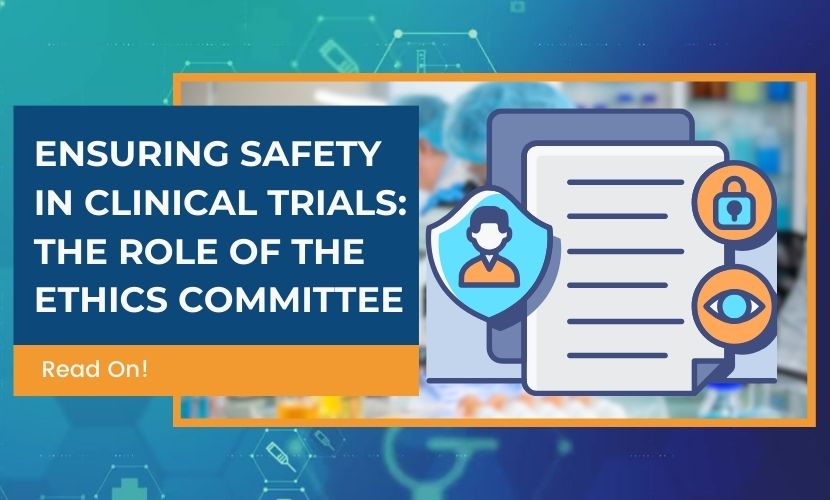Ensuring Safety in Clinical Trials: The Role of the Ethics Committees

Between 2013 and 2022, the Food and Drug Administration (FDA) approved an average of forty-three new drugs yearly. The drug approval process is rigorous and requires testing in animals and humans. Human testing is known as a clinical trial.
According to the National Institutes of Health (NIH), a clinical trial occurs when an investigational drug is created to alleviate a particular medical condition, the drug is applied to a specific number of patients, and the treatment of the condition is studied.
Clinical trials must adhere to strict protocols, including:
- Who can participate in the clinical trial
- Schedules and tests
- Dosages
- How long the study is conducted
- Safety
Clinical Trial Safety
The primary goal of a clinical trial is to investigate the effects of a drug in patients with minor differences such as race or ethnicity, gender, age ranges, length of time with a condition, etc. Because testing is the objective, negative side effects or results can occur in some patients.
Exclusion based on bias is strictly prohibited. There is an effort to push for diversity in clinical trials while maintaining safety for all. In recent years, women’s health has seen great leaps due to inclusion in the clinical trial space.
However, clinical research teams employ safety measures like clinical trial monitoring, human subject protection or informed consent, research participant rights, ethical review boards (ERBs) or institutional review boards (IRBs), and independent ethics committees (IECs) to best protect against adverse effects. These processes are known as clinical trial safety and include:
- Clinical Trial Monitoring: Each clinical trial is regulated by a body known as a Data and Safety Monitoring Board. The board tracks the results of each clinical trial. Their expert opinion of the results determines whether a trial can continue to the next phase or must stop due to adverse or harmful effects.
- Human Subject Protection or Informed Consent: Informed consent is a federal regulation that requires clinical research teams to obtain legal authorization from a patient or a patient’s guardian, stating they are fully aware of all information about the clinical trial.
- A proper informed consent process must provide all information regarding the novel drug, potential risks, threats, etc., followed by a conversation surrounding the information provided, answering any questions, and understanding the clinical trial is a volunteer event.
- As volunteers, patients are also given research participant rights, which state that patients can stop their involvement in the study at any time, and they can request up-to-date information about what the research suggests and any negative effects presently occurring.
- Ethical Review Boards (ERBs) or Institutional Review Boards (IRBs): Review boards referred to as institutional review boards (IRBs), ethical review boards (ERBs), independent ethics committees (IEC), or research ethics boards (REB) are a formal group dedicated to monitor and review bioresearch involving human subjects, clinical trials.
- Independent Ethics Committees (IEC): One of the final elements of clinical trial safety is independent ethics committees (IECs). These groups are respective IRBs or ERBs and comprise medical, scientific, and nonscientific clinical research members to help maintain human subject protection.
The Role of Independent Ethics Committees (IECs)
IECs repeatedly review the informed consent process for a clinical trial, including protocols and documentation. To ensure this is done correctly, IECs check that ethical guidelines for research are followed and applied to each clinical trial.
The ethical guidelines for research state that clinical trials must enact seven distinct parameters in each trial. According to the NIH, the seven parameters are social and clinical value, scientific validity, fair subject selection, favorable risk-benefit ratio, independent review, informed consent, and respect for potential and enrolled subjects.
- Scientific validity ensures that a clinical trial is created to provide results that will best answer the research question, that the research question itself is feasible, and that the trial protocols and processes are within scientific means.
- Fair subject selection refers to who can participate in a trial. Each trial should have specific criteria for who can be selected. Those selected for trials must fall within the requirements. However, this doesn’t mean trials can exclude anyone based on race, ethnicity, age, or sex if their other conditions remain within the trial criteria. If anyone is not selected to participate, clinical researchers must be able to provide scientific evidence and reasoning as to why.
- Clinical researchers must consider the benefits and risks that participants may experience during the trial. A favorable risk-benefit ratio allows researchers to ensure that the benefits outweigh the risks and that any risk potential is greatly minimized.
- Informed consent guarantees that patients decide to participate in a trial after knowing any benefits or threats during or after the completion of the trial.
- Respect for potential and enrolled participants encourages clinical researchers and team members to constantly and consistently treat participants in the best possible manner regarding their privacy and information, the choice to continue participation, keeping them abreast of changes in the trial and their health, and sharing the results of the trial’s analysis.
IECs begin before a trial and work to ensure that there is no inherent bias in the trial, that the trial was designed properly, that the favorable risk-benefit ratio is acceptable, and that the study continues human subject protection throughout the study.
Participant Safety in Trials
In addition to IECs, other processes must take place to help establish clinical trial safety for participants. They are referred to as the ethical review process.
One such measure is the ethical approval process. Ethical approval asserts that the clinical research team assessed the favorable risk-benefit ratio, found all known risks, minimized risks where applicable, and the benefits outweigh the risks.
Another process is oversight. There are several forms of oversight: ethical oversight in research and regulatory oversight in research. The oversight process includes a supervisory agency like an IRB, the FDA, the Office for Human Research Protections (OHRP), and the Department of Health and Human Services (HHS).
Ethical oversight focuses on informed consent and human subject protection processes like the favorable risk-benefit ratio, excluding bias in participants, and adverse event reporting.
Adverse event reporting requires reporting any unforeseen harmful effects presented in the clinical trial by a patient(s). The effects do not have to correlate with the drug being tested in the clinical trial.
Regulatory oversight enforces the requirements of the agencies and ensures that the results of a clinical trial remain in compliance. This process is known as regulatory compliance in clinical trials.
What to Expect as a Participant in a Clinical Trial
“Although each clinical trial is different, you can be assured that the processes put in place are consistent and work to ensure the best outcomes for patients with minimal risk involved. “
Many advancements have occurred in the clinical trial space, including several updates on clinical trial safety, like informed consent, governing bodies like IRBs and IECs, adverse event reporting, and favorable benefit-risk ratios.
Although each clinical trial is different, you can be assured that the processes put in place are consistent and work to ensure the best outcomes for patients with minimal risk involved.
Volunteers are essential to the success of clinical trials. Interested in joining a study or want to learn more? View a list of our currently enrolling studies.


